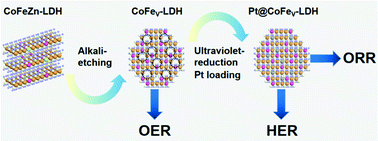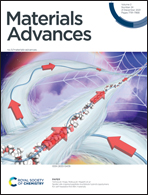Cation vacancy driven efficient CoFe-LDH-based electrocatalysts for water splitting and Zn–air batteries†
Abstract
Rational design of multifunctional electrocatalysts can optimize the mutual conversion of water and oxygen. CoFe-LDH-based electrocatalysts with highly tunable electronic, component, and catalytic properties have attracted considerable attention. Herein, we report the synthesis of cation vacancy rich CoFe-LDH (CoFeV-LDH) and its trace Pt loaded material (Pt@CoFeV-LDH, Pt dosage: 2.85%), which can act as an efficient electrocatalyst toward the oxygen evolution reaction (OER), hydrogen evolution reaction (HER), and oxygen reduction reaction (ORR). The electrolyzer comprising the CoFeV-LDH cathode and Pt@CoFeV-LDH anode exhibited excellent water splitting performance with a small cell voltage of 1.57 V to reach 10 mA cm−2 and 99% efficiency after 8 h. Furthermore, the liquid-state ZAB using CoFeV-LDH//Pt@CoFeV-LDH as air electrodes shows satisfactory charge–discharge performance with excellent reversibility of 50 h at 50 mA cm−2.

- This article is part of the themed collection: Popular Advances


 Please wait while we load your content...
Please wait while we load your content...